Individual Masses at St. Peter’s halted… Rumors of further restrictions on the Old Mass? Why? Why was the battle over our Liturgy? An Exclusive Essay by Bishop Schneider.
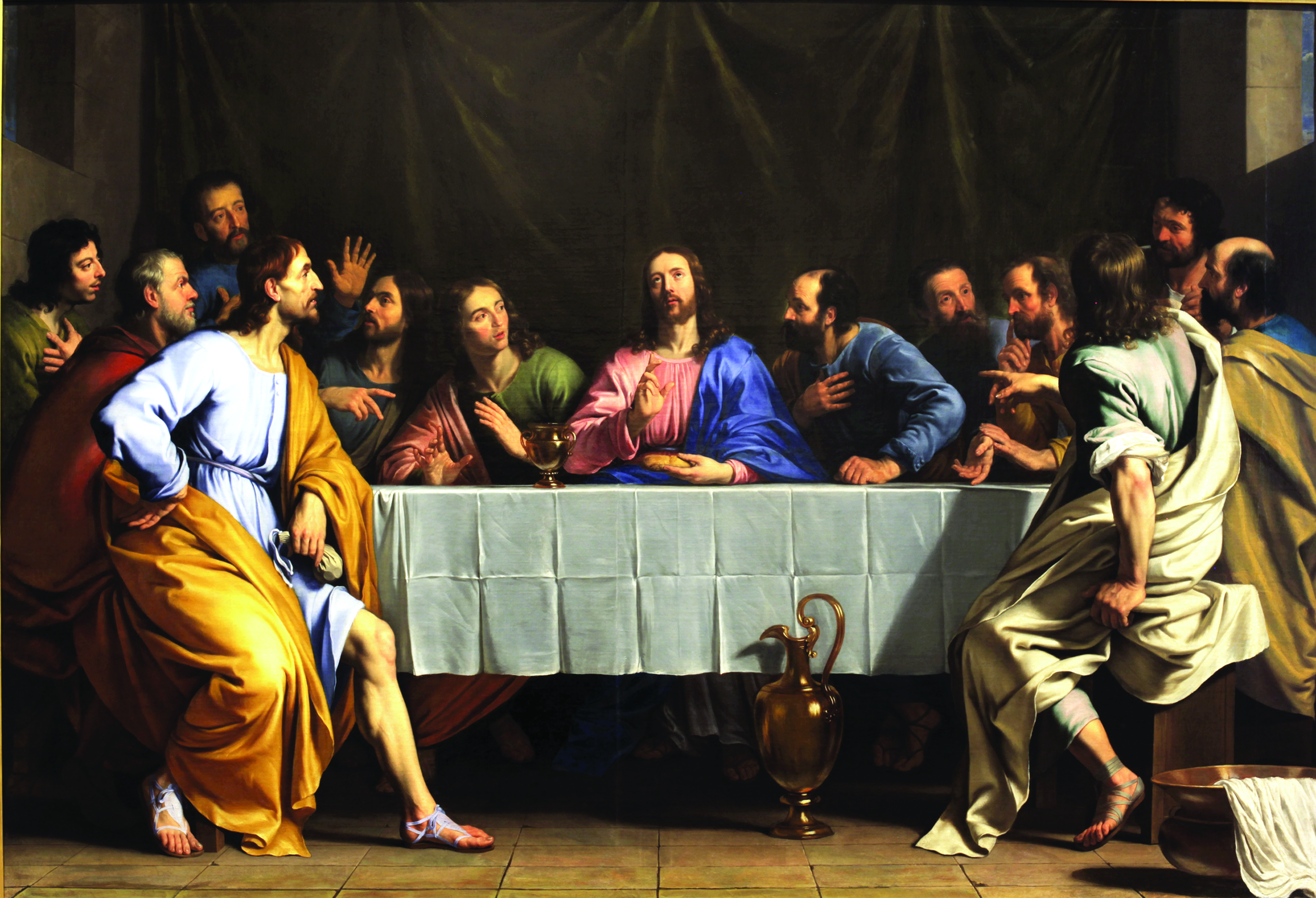
The Last Supper by Philippe de Champaigne, Musée des Beaux-Arts, Lyons, France
After individual Masses were suppressed at St. Peter’s basilica by an unusual decree pinned to the basilica sacristy doors March 11, many have expressed alarm that St. Peter’s might become, in the words of Cardinal Gerhard Müller, “more and more like a museum.”
Vatican journalist Edward Pentin, writing in the National Catholic Register on March 22, the first day in which the new rules were in force, noted that the basilica was “almost completely devoid of the Holy Sacrifice of the Mass.” Previously, there had been Masses being said on most of the 45 altars and 11 chapels in St. Peter’s.
Clergy who worked in the Vatican were accustomed to starting their days by saying Mass in St. Peter’s, sometimes alone. Now, all clergy are restricted to concelebrating one of four Masses scheduled from 7 to 9:30 am daily.
The stated reason: to foster an “atmosphere of recollection and liturgical decorum,” said the directive, initialed by Archbishop Edgar Peña Parra, deputy Secretary of State (though such matters are typically overseen by the basilica’s cardinal archpriest).
Cardinal Raymond Burke, Prefect Emeritus of the Apostolic Signatura, criticized the directive, saying it unjustly conditions priests to concelebrate Masses in violation of their freedom to offer the Mass individually, a violation of Church law.
Bishop Athanasius Schneider, Auxiliary Bishop of the Archdiocese of Saint Mary in Astana, Kazakhstan, a constant defender of Catholic liturgical tradition, in Christus Vincit (2019) a book-length interview with Diane Montagna, recalls the profoundly respectful eucharistic formation he received as a child. Warned that the then-novel practice of Communion in the hand had been introduced into the parishes of their adopted Germany, his family, who had emigrated from the Soviet republic of Estonia, felt confused. “We could not imagine how the Holy of Holies, the Living God, could be taken in the hand,” the bishop remembered. “That was for me inconceivable, really.”
Now Bishop Schneider comes to the defense of tradition in objecting to the new Mass prohibitions in St. Peter’s Basilica — at the very heart of our Eucharistic Lord’s Church, arguing that tradition in the liturgy is not a tool of factionalism, but an expression of the participation of every Catholic in the sacrificial remedy for sin offered by the God-man Himself. The Mass is our “thanksgiving” for the great sacrifice of Our Lord.
Bishop Schneider has crafted for Inside the Vatican a thorough, multi-faceted explanation of the concept of concelebration of the Mass, its history and purpose — and also its theological differences from individual celebration of the Mass by a single priest. His analysis follows. — Christina Deardurff
Eucharistic Concelebration
An essay on the liturgy by Bishop Athanasius Schneider, Auxiliary Bishop of the Archdiocese of St. Mary in Astana, Kazakhstan
Bishop Athanasius Schneider, 60, is Bishop of Astana, Kazakhstan. He was born in 1961 in the Kirghiz Soviet Socialist Republic. His parents were Black Sea Germans from Ukraine, sent by Stalin to a gulag in the Ural Mountains, where the family was part of the underground Church. In 1973, after making his First Holy Communion in secret, Schneider emigrated with his family to Rottweil in West Germany. In 1982 in Austria, Schneider joined the Canons Regular of the Holy Cross of Coimbra. Starting in 1999, he taught Patristics at the Catholic seminary in Karaganda. On June 2, 2006, he was consecrated a bishop in Rome. In 2011, he became auxiliary bishop of the Archdiocese of Astana. He is the General Secretary of the Bishops’ Conference of Kazakhstan.
By Bishop Athanasius Schneider
I. Eucharistic Concelebration: The Theological and Historical Aspect
The first Holy Mass was celebrated by Our Lord in the cenacle. This Mass did not have the form of a sacramental concelebration, because the apostles did not pronounce the words of consecration, but only the Lord pronounced them. The apostles participated in the Eucharist, celebrated by the Lord, by sacramentally receiving His Body and His Blood. We could say they “concelebrated” in the first Mass in the form of a non-sacramental concelebration.
From the earliest times, the universal Church (both in the East and in the West) conserved faithfully this original form of Eucharistic concelebration with these two characteristics:
The main celebrant alone pronounces the words of consecration.
The main celebrant is always and exclusively the “high priest,” i.e. the bishop (and, in Rome, the Pope).
In the beginning of the Middles Ages, in the Papal Liturgy in Rome there was a development of the original form by the fact that the concelebrants pronounced the words of consecration together with the Pope (cf. Ordo Romanus III, 8th century).
However, down to the present, the most ancient Oriental churches — the non-Catholic Greek Byzantines, the non-Catholic Copts, and non-Catholic Nestorians — have conserved the norm that only the main celebrant pronounces the words of consecration.
Until recent times in the universal Church, a priest never presided as the main celebrant of a Eucharistic sacramental concelebration.
From the 17th century on, the Byzantine Catholic churches introduced an innovation, that is, the form of concelebration among priests without a bishop as the main celebrant. Thereby the concelebration among priests became usual (cf. the article “Le rituel de la concélébration eucharistique” of Aimé Georges Martimort in Ephemerides Liturgicae 77 [1963] 147–168).
Such a form of Eucharistic concelebration only among priests was alien to the universal and constant tradition of the Church. Therefore the Roman Church forbade such concelebration among priests (cf. can. 803 of the Code of Canon Law 1917).
Only the Catholic Oriental churches adopted the custom that all concelebrants pronounce the words of consecration.
Until the Second Vatican Council, in the Latin Church a Eucharistic sacramental concelebration, where all concelebrants pronounce the words of consecration, was practiced only on three occasions:
Episcopal consecration: only the main consecrator and the newly consecrated bishops concelebrated.
Priestly ordination: only the bishop and the newly ordained priests concelebrated.
Chrism Mass on Holy Thursday in the Cathedral of Lyons (France): the bishop concelebrated with six priests.
For the Chrism Mass, the Roman Church conserved until the Second Vatican Council however the most ancient form, i.e. the words of consecration pronounced only the bishop, although twelve priests assisted him clothed with all the vestments required for Mass. With this form, the Roman Church perhaps wished to recount the first Holy Mass on Holy Thursday, where the main celebrant, Jesus the High Priest, alone pronounced the words of consecration while the twelve apostles concelebrated non-sacramentally, since they did not pronounce together with the Lord the words of the sacramental consecration.
In the millennial tradition of the Roman Church, sacramental Eucharistic concelebration constituted always an extraordinary solemn act, which occurred on:
Ecclesiastically important circumstances, which reflected the hierarchically ordered constitution of the Church, such as in the aforementioned episcopal consecrations and in priestly ordinations;
When the bishop celebrated Mass in a most solemn and hierarchically structured form, such as was the case in the Chrism Mass of Lyons, or when the Pope (in the first millenium) celebrated solemnly on the four highest feast in the year: Christmas, Easter, Pentecost, Ss. Peter and Paul (a custom that ceased in Rome in the high Middles Ages).
In all rites of all times, a solemn episcopal Mass always required the liturgical assistance of the representatives of all degrees of the clergy. In the Roman rite, such a Mass was structured as follows: priests wearing Mass vestments (so, for example, the ceremonial concelebrants in the case of the Cathedral canons “canonici parati,” prescribed in the ancient Caeremoniale Episcoporum), assisting priest, two assisting deacons, deacon and subdeacon of Mass, acolytes, lectors.
“The first Holy Mass was celebrated by Our Lord in the cenacle. This Mass did not have the form of a sacramental concelebration, because the apostles did not pronounce the words of consecration, but only the Lord pronounced them”
The solemn Papal Mass in Saint Peter’s before the Second Vatican Council had the same structure: cardinal bishops and cardinal priests, wearing Mass vestments, and cardinal deacons assisting the Pope. The cardinals concelebrated ceremonially, i.e. non-sacramentally.
The use of the sacramental Eucharistic concelebration in order to resolve practical problems in a gathering of a great number of priests or bishops is therefore entirely alien to the original and constant tradition of the entire Church. Such a use contradicts the original form and nature of the Eucharistic concelebration and constitutes a “degradation” of concelebration, as Martimort already noticed (cf. op. cit.).
The argument for extending the cases of concelebration on the occasion of priest gatherings in order to resolve practical problems of celebration figured in “Schema II” of the Constitution Sacrosanctum Concilium of the Second Vatican Council. This argument, however, was rejected by the majority of the Councils Fathers, so that it disappeared in the definitive text of n. 57.
A Eucharistic concelebration only among priests obscures an essential element of this form of celebration, i.e., the visibly recognizable hierarchical form. Each celebration of Holy Mass possesses its innate hierarchical form. The first Holy Mass in the cenacle revealed this characteristic: Jesus the High Priest was the main celebrant and He alone pronounced the words of consecration, being surrounded by the twelve first priests (bishops) of the New Covenant, who ceremonially assisted Him. Jesus was hierarchically higher and the ceremonially concelebrating apostles were lower. Since then, every authentic concelebration of the Holy Mass possessed this structure.
When a priest celebrates alone and without the sacramental concelebration of other priests, he alone represents Jesus the High Priest in the moment of the consecration, and all other priests who are present and do not pronounce the words of consecration (e.g., those who may be ministering as deacon or subdeacon, or any who are assisting in choir) are, at this moment, hierarchically lower from the point of view of the sacramental action, inasmuch as the celebrating priest alone acts at this moment sacramentally in persona Christi capitis, while the others do not.
Every Eucharistic celebration or concelebration has to demonstrate visibly the aspect of Christ the Head, i.e., that there is in the structure of the Church only one Head, Christ the High Priest. All other priests (presbyters, bishops) who are acting in the Eucharistic consecration in persona Christi capitis are only His visible vicars on different levels.
Therefore, the moment of realizing the Eucharistic consecration in persona Christi capitis — whether the consecration is made by only one consecrator or simultaneously by several consecrators — has to show visibly the uniqueness of the Head; in the case of a group of consecrators there has to be visibly one who is hierarchically higher, to show the uniqueness of Christ the Head.
From the point of view of the sign — and with the sacramental celebration, only one concrete person, in this case the main celebrant, visibly represents Christ the Head — it would be against the law of the sign-representation and of sacramental symbolism, when in the moment of the Eucharistic consecration a group of hierarchically equal persons simultaneously represents Christ, the one Head. “Indeed a pure multiplication of the concelebrants makes difficult the liturgical expression of their unity in Christ. How in this case is the Mass the act of the unique Priest?” (P. Tihon, “De la concélébration eucharistique,” Nouvelle Revue Théologique 86 [1964] 600, n. 97).
On the other side, the totality of the faithful represents the Mystical Body of Christ (Christus totus), because there are many hierarchically different members. There is, however, only a single Head in the Body, and therefore the Head is represented concretely by only one person in the visible acts of the life of the Church: both on the canonical level (jurisdiction) and on the Eucharistic level (celebration of the Eucharistic sacrifice).
The Eucharistic celebration is the sacrament which most perfectly realizes and visibly reflects the mystery of the Mystical Body with only one Head and one High Priest and with many hierarchically subordinated members.
On the canonical level, the Pope represents Christ the Head for the universal Church and the bishop represents Christ for the particular church (diocese).
On the Eucharistic sacramental level, the celebrant or the main celebrant (in the case of a concelebration) represents Christ the Head.
The one who represents Christ the Head at the moment of the Eucharistic consecration has to be as well “head” hierarchically or sacramentally in reference to the other concelebrants: this case is seen when the bishop concelebrates with priests, or a papal delegate (or the Metropolitan or the main consecrator in an episcopal consecration) concelebrates with other bishops, or when a priest celebrates alone.
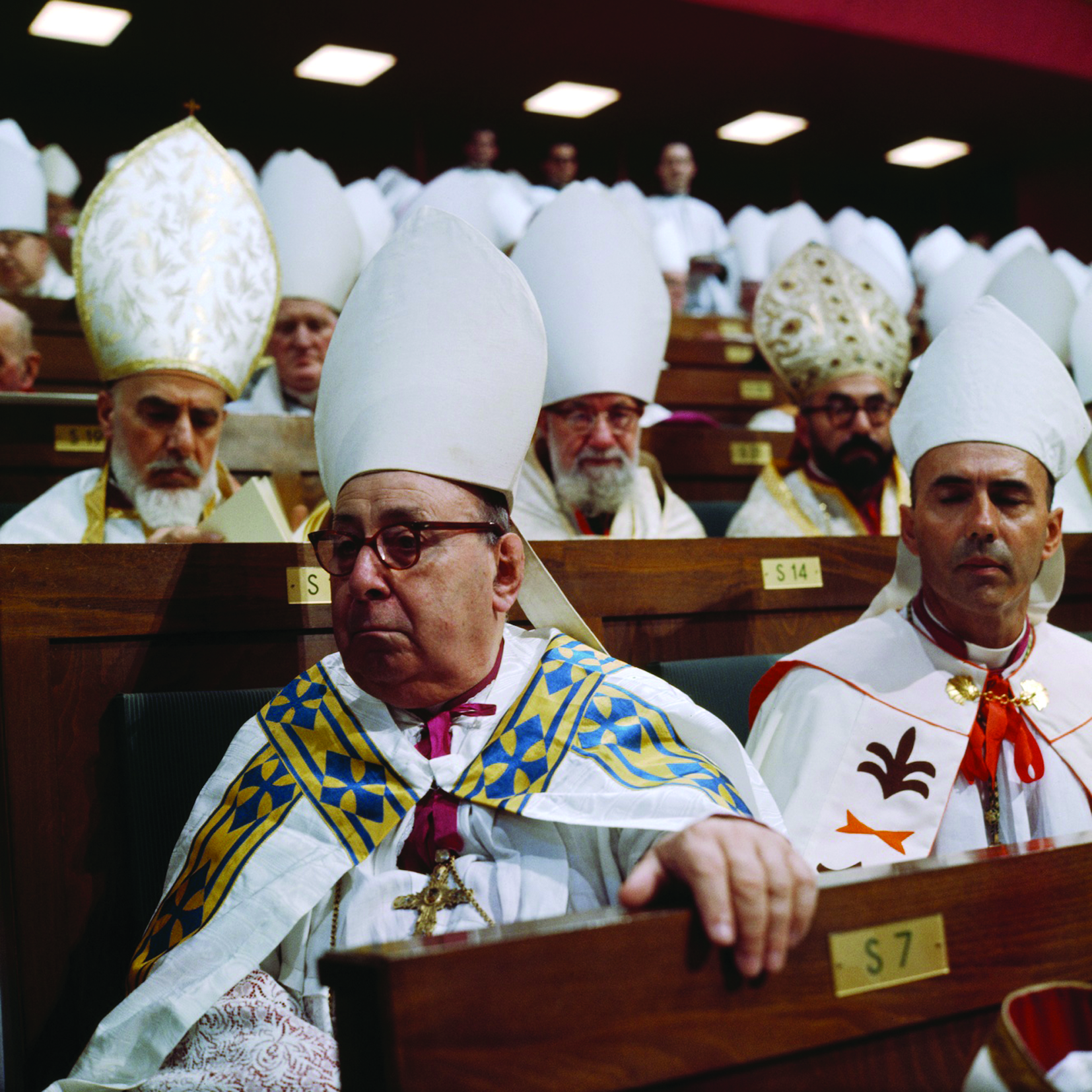
The French liturgist Monsignor Aimé-Georges Martimort during a session of the Second Vatican Council.
When several priests are realizing the Eucharistic consecration together and on the same level, the symbolism of the representation of the one Head is obscured, because there is no hierarchical difference of the Eucharistic co-consecrators, for none of them is a real “head” relative to the others on the hierarchical level. A hierarchical difference between Eucharistic co-consecrators guarantees convincingly the true symbolism of representing the only one Head.
Furthermore, having a main celebrant who is hierarchically higher and clearly distinguished as such also displays the truth that there is ultimately only one principal and main celebrant in each Mass, who is Christ the High Priest, the “minister principalis” of each sacrament, with all celebrants, even the main celebrant, occupying the rank of “minister secundarius.”
The essentially hierarchical structure of the visible Church has only one visible head as the vicar of Christ, the one sole Head (Vicarius Christi): Saint Peter and his successors, the bishops of Rome.
The Orthodox Churches rejected this truth of faith and created as a substitution for it an ecclesiology called “synodality” (sobornost in Russian). According to such a vision, the uniqueness of Christ the Head is not represented by one concrete person, i.e., Peter and his successors, but by the body or the collegium of bishops simultaneously, especially when gathered in a council or synod and sacramentally when concelebrating the Eucharist. In such a theory, there is no real visible head, but all are equal (“pares”). Consequently, the president of such a synod or of such a Eucharistic concelebration is only “primus inter pares.”
A Eucharistic celebration most perfectly reflects and realizes the mystery of the Church if and only if there is a real jurisdictional and hierarchical “primus.” Therefore, from the point of view of the sign and symbol, there must be among the concelebrants one who at the moment of the Eucharistic consecration is really “primus”:
Only sacramentally: when only one priest (however many are present) consecrates sacramentally, or
Sacramentally and hierarchically: when the bishop concelebrates with priests,
or
Sacramentally and hierarchically: when a bishop with ordinary or extraordinary papal delegation concelebrates with other bishops (the Metropolitan using the pallium, the main consecrator in the episcopal ordination, a Papal Legate).
It also obscures the hierarchical nature of the Eucharistic concelebration and reveals an egalitarian form, since in that scenario bishops and priest together constitute a kind of egalitarian group of concelebrants in reference to an episcopal main celebrant, who has not a real higher hierarchical position, as would be the case with a Metropolitan using the papal pallium, the main consecrator in an episcopal ordination acting on the base of a papal mandatum, or a specially appointed papal delegate.
The Pope is the visible sign of the unity of the episcopal order. The bishop, united with the Pope, is the visible sign of unity of the presbyterate. This must be visible also in the Eucharistic concelebration. A Eucharistic concelebration among bishops where the main celebrant has no papal delegation, not even a remote one, has a strong “egalitarian” characteristic. Likewise, a Eucharistic concelebration among priests without the bishop, has a strong “egalitarian” characteristic, since there is lacking as well the presence of the visible head of the presbyterium, i.e. the bishop.
Moreover, the egalitarian conception goes further, saying that what is essential is not the representation of Christ by one or by many priests, but His representation rather by the whole community that celebrates the Eucharist (cf. P. Tihon, op. cit., 593).
When a priest realizes the Eucharistic consecration alone (even though there could be present other not-concelebrating priests), he sacramentally makes visible Christ the one Head, acting in persona Christi capitis. Remotely, his singularity refers also to the bishop, the one head of the particular church, who in his turn is united with the Pope, the one head of the universal Church.
Therefore, a licit Eucharistic celebration has to mention expressly the bishop, one head of the local church and the Pope, one head of the universal Church. In the perspective of the truth that there is no “primus inter pares” in the hierarchical constitution of the Church, but that there is “one head” universally (Pope), locally (bishop), and sacramentally (the consecrating priest in persona Christi capitis), the highest sign of the unity of the priesthood is not the Eucharistic concelebration among priests without the bishop as main celebrant, but the Eucharistic concelebration of the priests with the bishop, as occurs in the Mass of priestly ordination. In the rite of priestly ordination it is said that the unity of the Body of Christ is made up by members who are many and different as to the dignities: “ex multis et alternae dignitatis membris unum Corpus Christi efficitur” (Allocutio episcopi).
The form of the sacramental concelebration (as occurred in the Mass of the Pope with the cardinals only four times in the year from the 7th 8th centuries) appeared gradually in later centuries also in the Mass of episcopal consecration and of priestly ordination (in this case it became obligatory only in 1596). At the same time, the Eucharistic concelebration of the Pope with the cardinals gradually disappeared, and remained a ceremonial concelebration of the Pope with the cardinals.
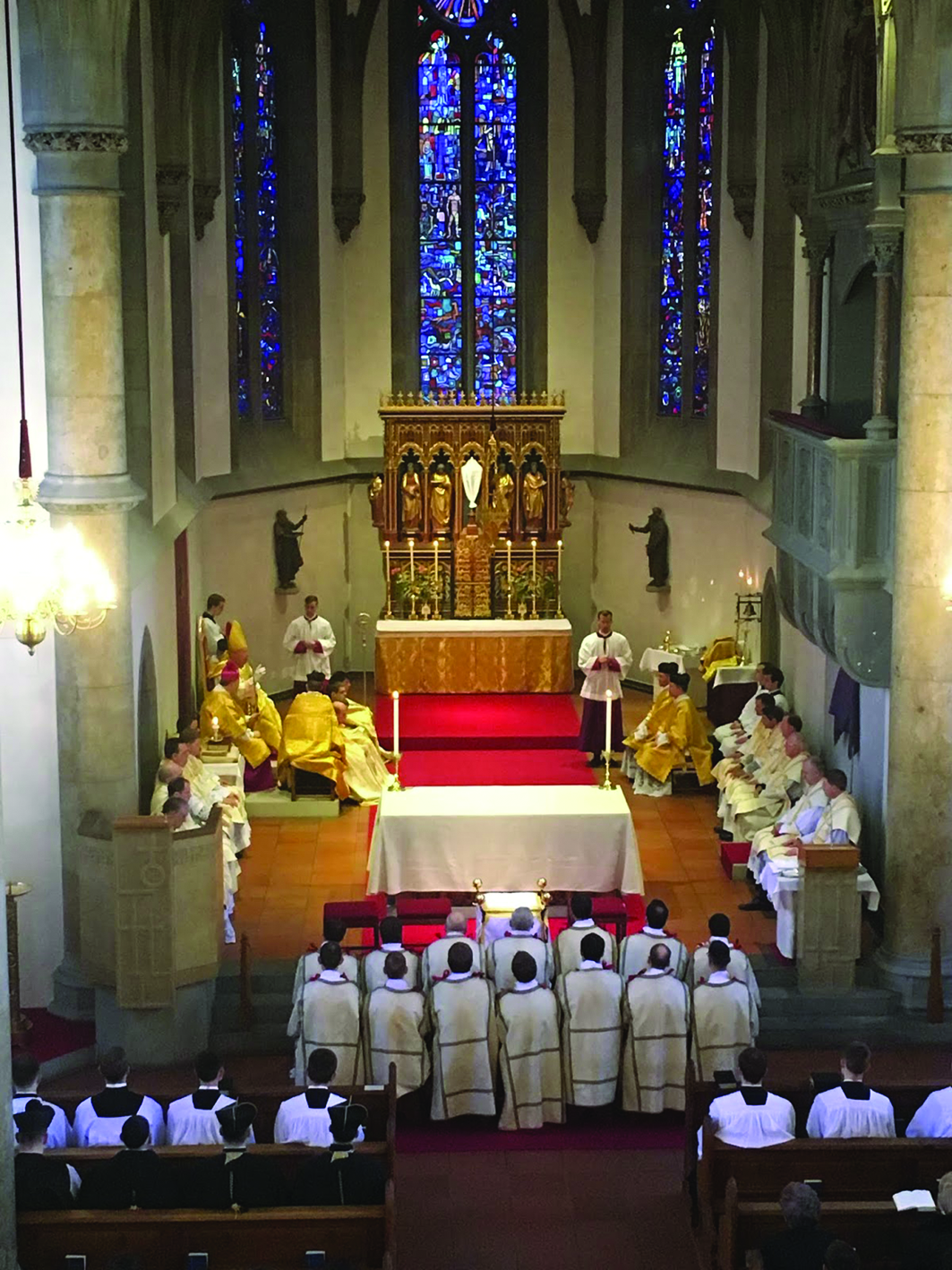
A Mass according to the ancient rite in Vaduz, Switzerland, celebrated by Bishop Haas
According to the original and perennial sensus ecclesiae, the Eucharistic concelebration is the most solemn form of the Mass and not a simple and daily form of celebration. St. Ignatius of Antioch (1 2nd centuries) and the Traditio Apostolica (3rd century), for example, mentioned it: during the Mass the bishop is surrounded by his whole presbyterium, by the deacons and other servers and the whole assembly of the faithful.
The Traditio Apostolica says that only the bishop speaks the Eucharistic prayer.
The most Greek Orthodox monasteries of the Mount Athos, for instance, do not practice a daily Eucharistic concelebration.
They preserved the original tradition of a Eucharistic concelebration – always in a ceremonial and never in the sacramental form – only on a few main feasts during the year (cf. Hagioreitokon Typikon tes Ekklesiastikes Akoloutheias, Athena 1997, I part, chapter 1, note 28).
The custom of the some Oriental Catholic churches with a regular Eucharistic concelebration of priests without the bishop, which is indeed ultimately an “egalitarian” and not a strictly hierarchical form, was erroneously considered by representatives of the Liturgical Movement in the 20th century as the authentic and original model of Eucharistic concelebration, of which they strongly demanded a “restoration” in the Latin Church.
Until the Second Vatican Council, the Roman Church conserved this original form of the Eucharistic concelebration according to the norm of the Fathers (“pristina norma Patrum”) in the Chrism Mass, where twelve priests, wearing Mass vestments, concelebrated ceremonially with the bishop, surrounded by seven deacons and seven subdeacons. The numbers twelve and seven are representative and symbolic numbers for the totality of the respective degrees of the clergy.
The original and older form, non-sacramental or ceremonial Eucharistic concelebration, such as it was in the Chrism Mass, coexisted in the Roman Church with the later form of the sacramental Eucharistic concelebration in the case of the Mass of the episcopal consecration and priestly ordination.
On the eve of the Second Vatican Councils, there were many requests to harmonize these two forms of Eucharistic concelebrations in the Roman Church, i.e., to extend the sacramental Eucharistic concelebration also to the Chrism Mass, as occurred in the Rite of Lyons until the Second Vatican Council and in several French dioceses until the 19th century (cf. Martimort, op. cit.).
The call for extending the possibility of Eucharistic concelebration on the eve of this Council was very loud. The Council Fathers were surrounded by an atmosphere of euphoria, of uncritical approval of the new “concelebration theory,” of a lack of deeper reflection about sacramentological and ecclesiological aspects linked with Eucharistic concelebration.
The Second Vatican Council indeed extended the possibility of Eucharistic concelebration formally to six cases (Sacrosanctum Concilium, n. 57). The norms were, however, so “elastic” that in fact there is nowadays a total liberty of concelebration, a liberty post-conciliar documents even favored.
The Second Vatican Council had no intention of deciding about the theological and even less about the historical problems of concelebration. “The Council gave no definition, no description of concelebration, there being different and opposite theological tendencies” concerning it (P. Tihon, op. cit., 579).
The actual practice of Eucharistic concelebration in the Latin Church constitutes a great rupture with the constant tradition of the Roman Church and of the most Oriental churches, for it obscures the original sense and form of this concelebration as Christ entrusted it to the Church and as it was faithfully transmitted by the Roman Church in the last two millennia.
The actual practice of Eucharistic concelebration in the Latin Church has trespassed nowadays often the limits of liturgical dignity and theological meaning, especially in the frequent cases of “mass concelebrations” or “oceanic” concelebrations with several hundred and even thousands of concelebrants.
The frequent daily concelebrations among priests (or among bishops) disfigures the original sense of Eucharistic concelebration, according to which such a celebration must be clearly hierarchical (and not in an egalitarian form) and also must be the most solemn form of the Eucharistic celebration.
A daily sacramental Eucharistic concelebration diminishes over time a deeper, closer, and more personal relationship of the priest with Christ the High Priest during the offering of the Holy Mass, which is the very center of priestly life.
The Eucharistic celebration always had in its form several degrees of solemnity. The highest and most solemn form of the Mass was the Pontifical High Mass, and such Pontifical Masses always conserved in the Roman Rite th essential elements of the original Eucharistic concelebration, i.e., of the non-sacramental or ceremonial concelebration. Prior to the post-conciliar liturgical reform, such Pontifical Masses with ceremonial concelebration had three forms:
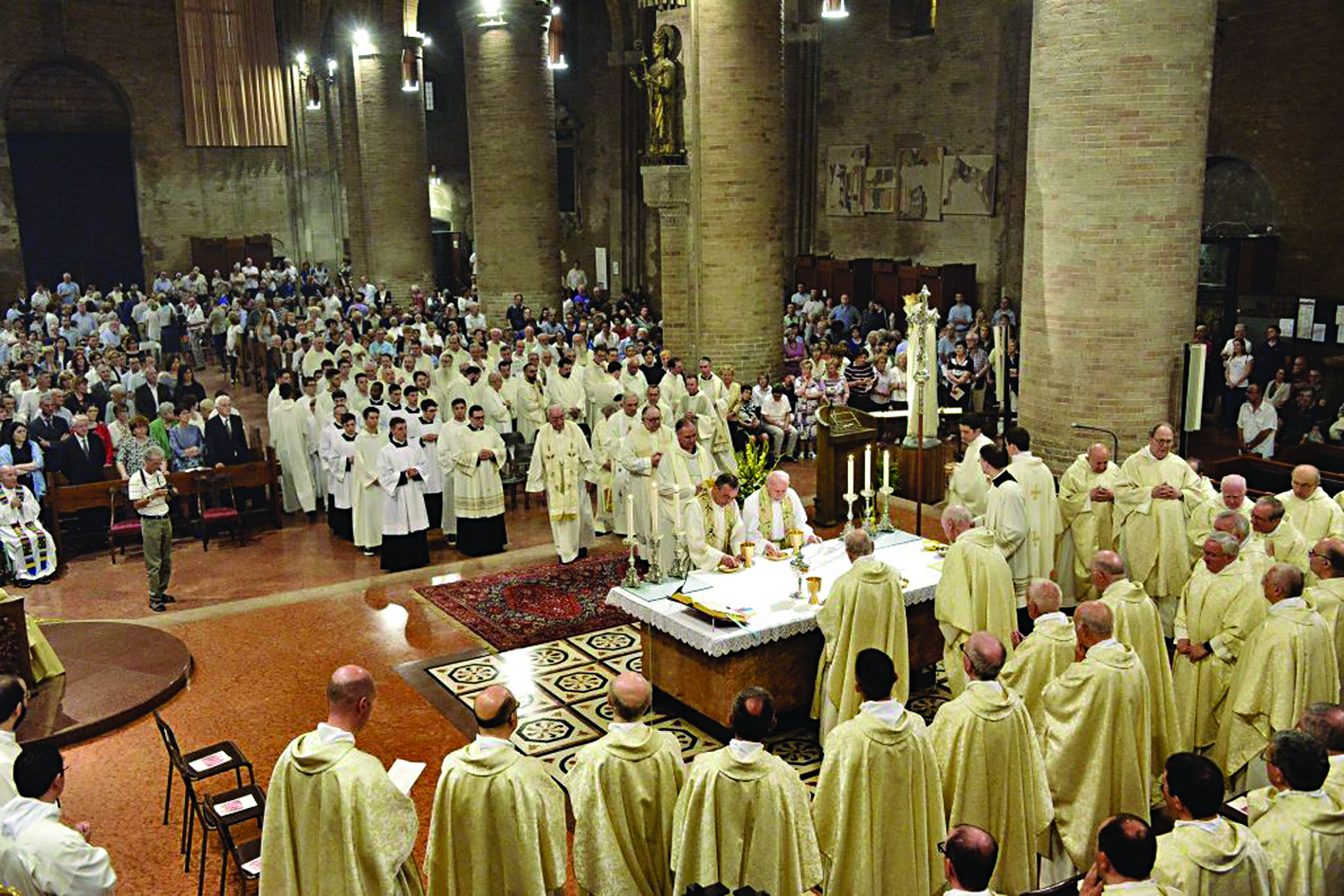
A Mass concelebrated in the Cathedral of Lodi, Italy, for the ordination of priests.
“Nowadays the actual practice of Eucharistic concelebration has often trespassed the limits of liturgical dignity”
The solemn Pontifical Mass ad thronum in the Cathedral the bishop was surrounded by some Canons, wearing Mass vestments (“canonici parati”), with assisting priest, assisting deacons, deacon and subdeacon, acolytes. The Chrism Mass with twelve priests, wearing Mass vestments, seven deacons and seven subdeacons. This was really the most solemn Mass in a diocese. The solemn Papal Mass in Saint Peter’s Basilica, where cardinal-deacons, cardinal-priests, and cardinal-bishops, wearing Mass vestments, surrounded the Pope and served or concelebrated ceremonially. This was the most solemn form of Mass in the universal Church. Such solemn Masses were celebrated rarely, as was also the case in the first millennium, where the Pope sacramentally concelebrated with the cardinals only four times in the year (Christmas, Easter, Pentecost, St. Peter and Paul).
The renowned liturgist A. Martimort acknowledged the character of the particularity and the solemnity of a sacramental Eucharistic concelebration, saying: “More delicate is the problem of the conditions to which concelebration should be submitted, concerning their dates, the number and the quality of the concelebrants. The liturgists remark that concelebration in itself is a rare and a somewhat exceptional thing, as it has always been in the West and as it is in the East — if not in practice, yet in principle” (op. cit.).
On the eve of the Second Vatican Council, Martimort made this theologically correct and practically balanced proposal for an extended practice of the Eucharistic concelebration: “One should imagine concelebration in the Latin Church only around the diocesan bishop, with him presiding at the celebration: it finds a normal place in the Mass where the bishop is surrounded by his clergy, clothed in vestments for Mass (clergé paré)” (op. cit.).
Martimort makes the following concrete suggestions about the extension of cases of concelebration: “There are three cases, in which concelebration is demanded: in the case of the co-consecrators of the episcopal consecration, in the case of the priests in the Chrism Mass on Holy Thursday, [and] in the case of a great manifestation of the Church, where some priests surrounding the celebrant express the universality of the catholica” (op. cit.).
If the practice of Eucharistic concelebration was to have been extended, it should have been done according to the authentic and perennial theological and ecclesiological meaning, i.e., it must fulfill simultaneously the following essential characteristics:
There must be the sign of hierarchical unity and universality (catholicity): therefore, no egalitarian form; therefore, no concelebration among priests alone or among bishops without a papal delegate or without the Metropolitan, using the pallium.
There must be the sign of particular solemnity: therefore, no daily concelebrations, but only in the particular important events of the universal Church (Ecumenical Councils) and in the particular Churches: episcopal consecration, priestly ordination, Chrism Mass, diocesan synod, provincial council (the different particular churches of the same ecclesiastical province), plenary council (all the particular churches of the same conference of bishops).
There must be the sign of particular ritual dignity and beauty: therefore, no “stadium concelebration” and — with the exception of priestly ordinations — necessarily a concrete limitation of the number of concelebrants (e.g., a minimum of two and a maximum of twelve concelebrants), as was exemplified by the almost millennial well-tried experience of the Roman Church, the Rite of Lyons, and some French dioceses after the Council of Trent.
Considering the above-mentioned ecclesiological, sacramentological, and liturgical aspects, one can make the proposal that the sacramental Eucharistic concelebration in the Roman Rite should comprise the following seven cases:
Episcopal consecration;
Priestly ordination;
Ecumenical Councils;
Provincial Councils;
Plenary Councils;
Diocesan synod;
Chrism Mass.
The highest form of the exercise of the Magisterium (councils on the universal, regional, and local levels) could be appropriately linked also with the highest form of the exercise of the Eucharistic celebration, i.e., with the sacramental Eucharistic concelebration, showing the indissoluble link of the lex credendi with the lex orandi.
The nature of Divine worship requires that in the liturgical life of the Church there must be a particularly solemn and not-daily form of the Eucharistic celebration, and we should see this in a hierarchically structured Eucharistic concelebration.
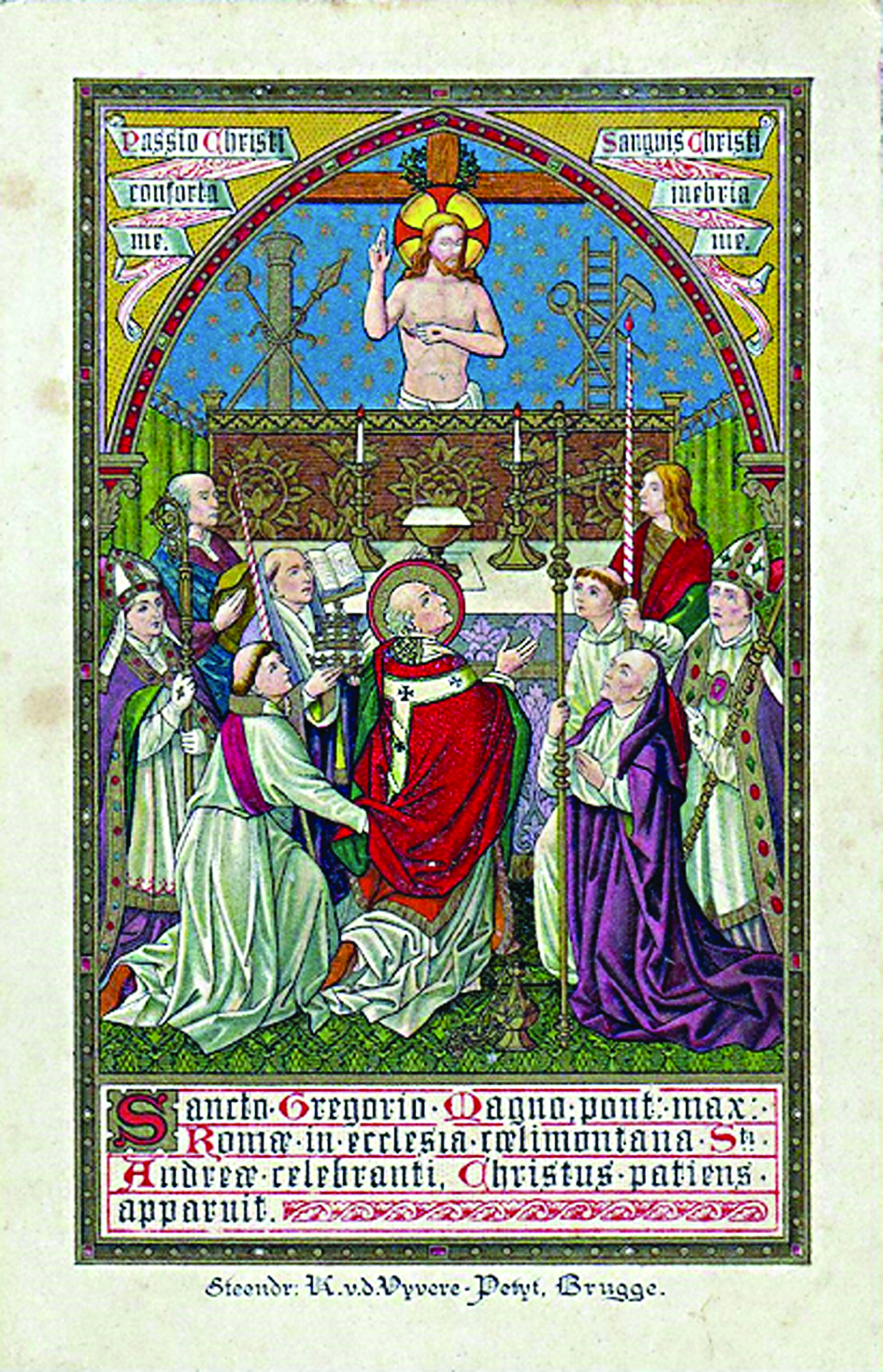
A depiction of a Mass celebrated by St. Gregory the Great, showing the appearance of the living Christ
Martimort warned prophetically in 1960 on the eve of the Second Vatican Council: “It is the occasion to admonish that concelebration will be a very demanding thing from the point of view of the quality of the things and the material organization” (op. cit.).
P. Tihon said in 1964: “Concelebration should not be done on discounts. Moreover, a dignified celebration, executed according to the norms, imposes a limited number of participating priests, and it would be almost impossible during big gatherings of priests, such as during the Eucharistic Congresses for example” (op. cit., 606).
According to the example of the Oriental non-Catholic churches (where there is no sacramental concelebration at all) and the ancient norm of the Fathers (pristina norma Patrum), the strictly sacramental Eucharistic concelebration should be reduced to the above-mentioned cases and the non-sacramental concelebration, which is the original form, should be more extended, such as it is the Pontifical High Mass according to the traditional Roman Rite, the usus antiquior of the Roman Rite.
A non-sacramental Eucharistic concelebration very beautifully demonstrates as well the hierarchical order of the Church and of the celebration itself. This is witnessed when only one priest or bishop performs the Eucharistic consecration, whereas other priests or bishops assist the Mass in the sanctuary (presbyterium), wearing the distinctive sign of their priesthood or of their ecclesiastical office. Even though not consecrating sacramentally, they nevertheless concelebrate with the one priest or bishop in the original form of the concelebration, i.e., in the form in which Christ the High Priest celebrated the first Holy Mass on this earth on Holy Thursday.
A practice of the sacramental Eucharistic concelebration, presided over by the bishop and restricted to very particular and solemn occasions, would be the most appropriate form, as Martimort stated: “This concelebration seems to us a more sure way, more immediately practicable and more in conformity with the evolution of priestly piety” (op. cit.).
II. The Liturgical Aspect
A ritually dignified and theologically sure sacramental Eucharistic concelebration demands necessarily a numerus clausus [closed number] of concelebrants. It is a constant law of the universal tradition of the Church that the Eucharistic consecrator has to be in bodily contact with the place of sacrifice and consecration in order to be able to touch the altar. The minister of the sacrament has to be corporally close to the materia. The words “Hoc est corpus… ,” “Hic est sanguis…” demand that the materia is really present to the consecrator. In the Latin Tradition (with the exception of the newly ordained priests in the usus antiquior) the sacramental co-consecrators had to stay immediately at the altar, as for example in the Mass of the episcopal consecration and in the Chrism Mass in the Rite of Lyons. The same rule is observed in the Oriental rites still today. In view of a dignified Eucharistic concelebration, Martimort suggested establishing a numerus clausus of concelebrants (cf. op. cit.).
The Latin Church has a well-tried model for such a ritually dignified and theologically sure sacramental Eucharistic concelebration in the centuries-old form of concelebration in the Mass of the episcopal consecration and in the Chrism Mass of the Rite of Lyons. Concerning the ritual aspect, Martimort suggested: “The Chrism Mass of Holy Thursday would be the most sure and comfortable occasion for such an evolution of the discipline: it would be sufficient to extend to the universal Church the custom of Lyons” (op. cit.).
More concretely, Martimort made this proposal: “I would gladly adopt the rubrics of the episcopal consecration or the living custom of Lyons, which prescribe for the concelebrants the recitation in a middle tone of all prayers said by the main celebrant from the Offertory to the Communion; for the sung parts, the bishop sings alone, while the other concelebrants recite in a low voice” (op. cit.).
In the Roman Rite the sacramental Eucharistic concelebration should regularly not exceed the number twelve for concelebrants, except in the Mass of priestly ordinations.
This custom has a centuries-long tradition in the Chrism Mass.
The number twelve recounts the number of twelve Apostles during the first Holy Mass in the cenacle on Holy Thursday.
Furthermore, this number symbolizes fullness.
The minimum number of concelebrants would be two, because of the minimum requirement of beauty and solemnity, which two symmetrically placed concelebrants express.
During the catechumenal part of the Mass, the concelebrants are placed symmetrically on seats on each side of the sanctuary or on the right and left side of the episcopal throne.
From the Offertory on, the concelebrants stay symmetrically on each side of the altar.
At the front side of the altar, the main celebrant stays alone with the assisting priest, deacon, and subdeacon.

The elevation of the Sacred Host and of the chalice during a Mass in the old Latin rite.
This position manifests visibly that there is really a main celebrant, who in this moment represents Christ the one Head. The other concelebrants, his helping co-consecrators, are therefore placed on the sides of the altar. This position has also a practical advantage: there is guaranteed an unhindered ministry of the assisting priest, deacon, and subdeacon, as well as the incensation of the altar.
Because of the presence of concelebrants at both sides of the altar, the altar during the Offertory is incensed in the front part, and not in a circle around. When the sides of the altar are not sufficiently long, the remaining concelebrants stay in two rows one behind the other.
All the prayers from the Offertory to the Communion (except the Offertory verse, the Secreta or Oratio super oblata and the Preface) the concelebrants pray in a low voice together with the main celebrant, who prays them aloud.
During the Canon Missae, the concelebrants perform together with the main celebrant the following gestures:
During Hanc igitur holding the hands spread flat so that the right thumb is over the left and joining the hands at the conclusion Per Christum Dominum nostrum.
During the pronunciation of the words of the consecration, the concelebrants bow.
All genuflect immediately after each consecration.
During the elevation of the sacred host and of the chalice, the concelebrants look upon them.
All genuflect after each elevation.
They make a profound bow, kissing the altar and crossing themselves during Supplices te rogamus.
They strike the breast at the beginning of Nobis quoque peccatoribus;
The rite of the Pax is according the ritual of the episcopal consecration.
During the Domine, non sum dignus, the concelebrants strike the breast three times, together with the main celebrant.
The rite of Communion of episcopal concelebrants is similar to that of the Mass of episcopal consecration. Each concelebrant approaches the main celebrant, who stands at his place in the center.
The concelebrant genuflects towards the Blessed Sacrament, and the main celebrant lays the sacred host directly on the tongue of the concelebrant, who is standing and slightly bowing, then the main celebrant gives the chalice to the concelebrant and the concelebrant, holding the chalice with his hands, drinks from the chalice.
The main celebrant does not say any words while giving Holy Communion to the concelebrants nor does he make the sign of cross with the sacred host.
The concelebrants purify themselves drinking from a chalice of unconsecrated wine at the credence.
The rite of Communion of priestly concelebrants: the concelebrants kneel down in a row on the top step of the altar; the bishop lays the sacred host directly on their tongue, while attended by the deacon and subdeacon, the deacon holding the paten. The concelebrants remaining still kneeling, awaiting the bishop to return with the chalice; the bishop holds to the lips of each concelebrant the chalice, from which he drinks a sip, while the deacon holds a purificator beneath the chin of each one. The bishop does not say any words while giving Holy Communion to the concelebrants nor does he make the sign of cross with the sacred host. The concelebrants purify themselves drinking from a chalice of unconsecrated wine at the credence.
The fact that the concelebrants and even the episcopal concelebrants receive the Body and Blood of Christ from the main concelebrant demonstrates in a very impressive manner the hierarchical aspect of the Eucharistic concelebration, stressing that there is only one Head and one High Priest Christ, who is visibly represented by the one main celebrant who at that moment is His true vicar (vicarius Christi).
The rite of concelebration in the Mass of the priestly ordination should remain unchanged, except the rite of Communion, which could be done as described above. There are following reasons for maintaining the traditional rite of concelebration for the priestly ordination:
The eminent pedagogical character. For the newly ordained priest there is given this psychologically very appropriate gradual introduction to the awesome and sacred moment of offering for the first time the unbloody Sacrifice of the Cross.
So the neo-presbyters remain behind the bishop and not directly at the altar, and in a kneeling position.
This all expresses the necessary spiritual attitude at such a moment: that one can approach to the Holiest of Holies only with deep humility, with a holy and tactful reserve.
Like docile and astonished “apprentices,” the newly ordained priests are introduced to realizing the greatest spiritual power which is given to men, i.e., to offer the Sacrifice of the Cross and transubstantiate in persona Christi bread and wine into the immolated and living Body and Blood of Christ. Indeed, in the allocution before the ordination, the bishop says: “cum magno timore ad tantum gradum accendendum est” (one must ascend to such a great degree with much fear). In the last admonition at the end of the Mass, the bishop says to the newly ordained priest that the celebration of the holy Mass is a “quite dangerous thing” (“res, quam tractaturi estis, satis periculosa est”). Therefore, says the bishop, before they start to celebrate Mass, they have to learn to celebrate it diligently from well-versed priests (“ab aliis iam doctis sacerdotibus discatis”).
The rite of priestly ordination unfolds gradually, through impressive signs and actions, the various spiritual powers of the priesthood: first the power to offer the sacrifice of Mass and then the power to absolve the sinners in the sacrament of penance. Therefore, at the end of the Mass the bishop unfolds ritually the chasuble, whose back side had been pinned up, pronouncing the words: “Receive the Holy Ghost: whose ever sins you remit, they are remitted,” etc.
The subordinated place and position occupied by the neo-presbyters relating to the celebrating bishop is a very eloquent demonstration of the theological truth that the priests possess the “munus secundi meriti” (cf. Prayer of the ordination), i.e., they have the second, subordinate degree of the priesthood. They are called in the rite of ordination “sacerdotes minoris ordinis” (cf. Allocutio episcopi).
It demonstrates the fact that a priest may not licitly celebrate the Holy Mass unless he has either actual or habitual authorization from the bishop of the diocese. In celebrating Holy Mass, the priest is in some way always dependent on and subordinated to the bishop of the place.
In non-sacramental Eucharistic concelebrations when priests or bishops assist in the sanctuary without Mass vestments, they should receive Holy Communion from the hands of the main celebrant.
They wear the stole and, kneeling on the top step of the altar, receive the Body of Christ directly on the tongue.
Then they could receive also the chalice of the Blood of Christ.
Their participation at Mass and at Holy Communion should be in some way distinguished from those who are not sacramentally ordained or not priests.
Conclusion
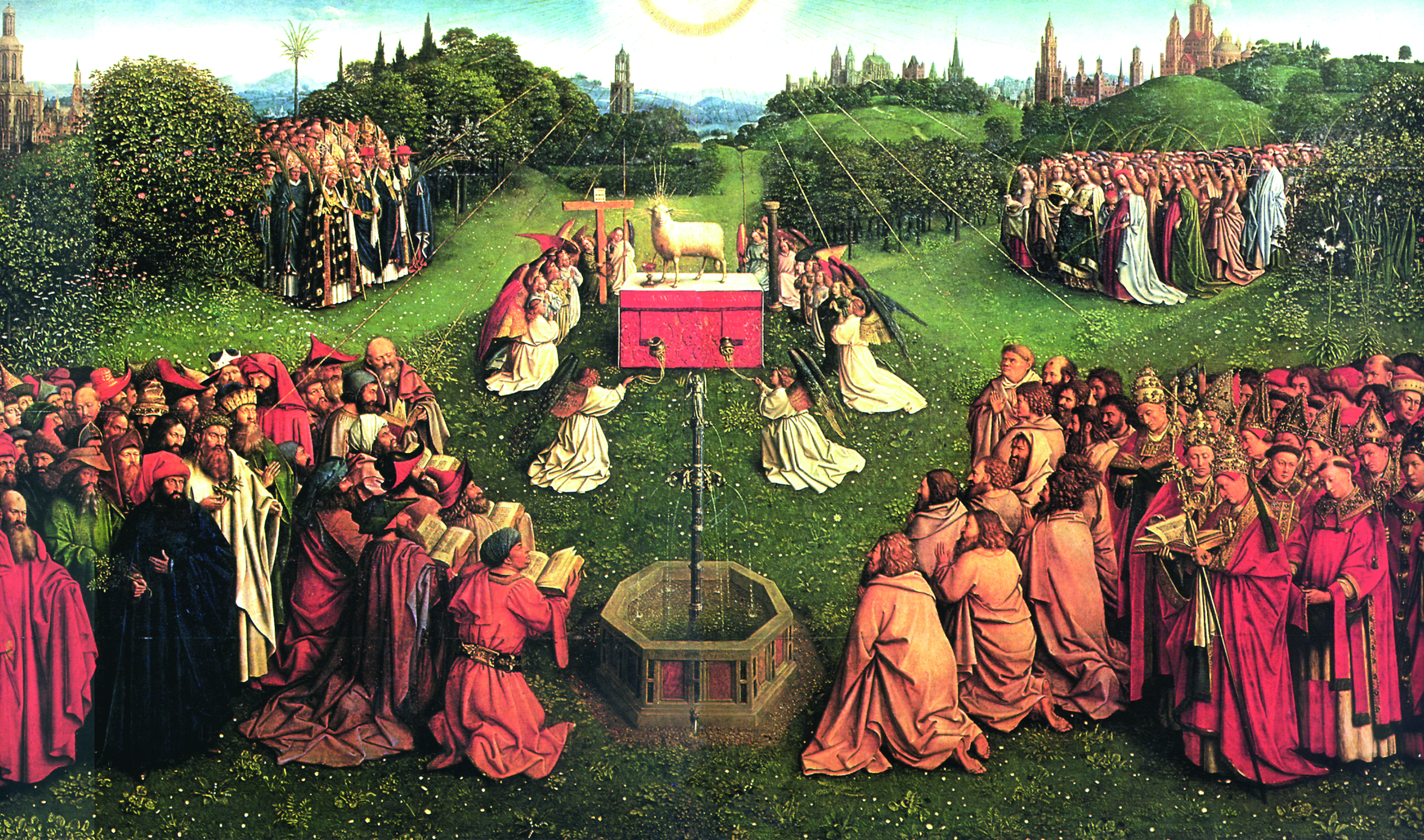
A panel of The Ghent Altarpiece (or The Adoration of the Mystic Lamb, Dutch: Het Lam Gods), St. Bavo’s Cathedral, Ghent, Belgium
In conclusion, it is worthwhile to quote the following apt observation of a great Catholic Anglican theologian, Dr. Eric Mascall, as reported by Fr. John Hunwicke:
“If, Mascall wrote, you want to make ‘anybody understand wherein the corporateness of the Mass really consists,’ the best thing you can do is to take him into a church with lots of simultaneous private Masses going on, and tell him that ‘the different priests saying their different Masses at their different altars are doing not different things but the same thing, that they are all taking part in the one eternal Liturgy whose celebrant is Christ and that their priesthood is only a participation in his… the multiplication of Masses emphasises the real unity of the Mass and the true nature of the Church’s corporate character as nothing else can… what makes the Mass one and corporate is not the fact that a lot of people are together at the same service, but the fact that it is the act of Christ in his body (corpus) the Church… Look at those men at their various altars all around the church, each of them apparently muttering away on his own and having nothing to do with the others. In fact, they are all of them doing the same thing — the same essentially, the same numerically — not just a lot of different things of the same kind, but the very same identical thing; each of them is taking his part as a priest in the one redemptive act which Christ, who died for our sins and rose again for our justification, perpetuates in the Church which is his Body through the sacrament of his body and blood’” (liturgical notes. blogspot.com, 13 March 2021).
Fr. Hunwicke concludes saying: “How wonderful it would be if the scene he describes returned to the life of our churches… just imagine the basilica at Lourdes every morning with a constant coming and going of priests to the altars of the fifteen mysteries.”
The Eucharistic celebration is the most perfect and effective sign of the Church, the Mystical Body of Christ, in its admirable unity, which is built up by hierarchical diversity. Therefore, the practice of Eucharistic concelebration must be such that it visibly demonstrates this truth more clearly.
There is only One Christ, the One Head and One High Priest, who is the principal celebrant of the Mass.
The original, universal, and constant practice of Eucharistic concelebration according to the pristine norm of the Fathers (pristina norma Patrum) is the particularly solemn form, presided over by a main celebrant, who hierarchically must be distinguished from the other concelebrants — one who is not only “primus inter pares,” but also visibly one “head,” representing as “vicarius Christi” on different levels — Pope, Papal Legate, Metropolitan, diocesan bishop, ordaining bishop with papal mandatum — the One Divine Head of the whole Body.
To such a form of Eucharistic concelebration could be applied these words of Saint Paul about the Mystical Body of Christ: “From whom the whole body fitly joined together and compacted by that which every joint supplies, according to the effectual working in the measure of every part, makes increase of the body unto the edifying of itself in love” (Eph 4:16). The Mystical Body of Christ is an organic and living hierarchy of order and love.
And so should be the form of the most solemn celebration of the Eucharist, the sacramentum Corporis Christi, which is the sacramentum caritatis, since the deepest sense of the Corpus Christi Mysticum is revealed in the Corpus Christi Eucharisticum. May the practice of the sacramental Eucharistic concelebration once again be “bene ordinata… ad pristinam normam Patrum” — “well-ordered according to the ancient norm of the Fathers.”
This was meant to be a guiding principle of the Second Vatican Council’s renewal of the sacred liturgy (cf. Sacrosanctum Concilium, 50) and of the Tridentine reform of Pope Pius V. (cf. the bull “Quo primum”).


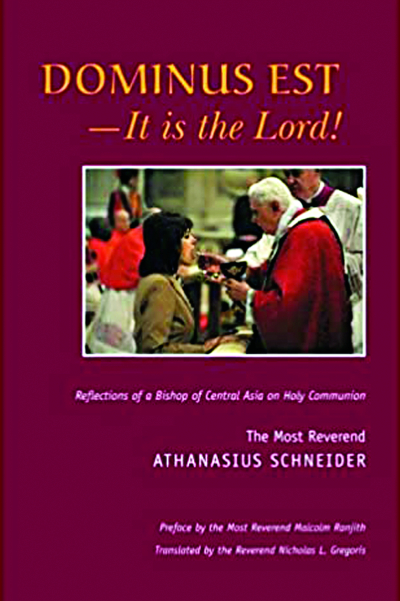
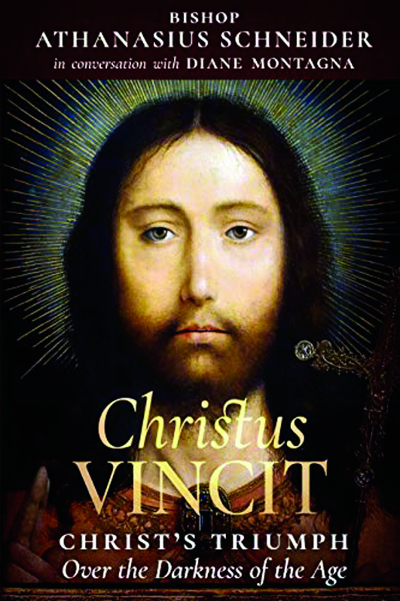
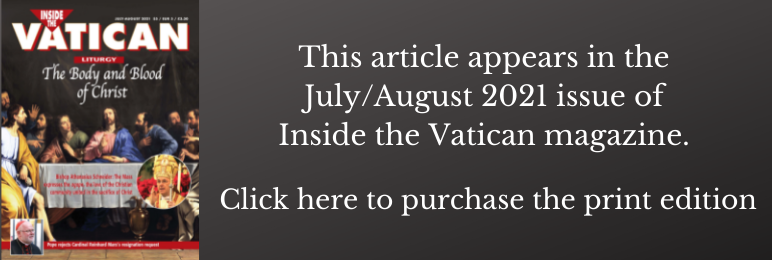





Facebook Comments